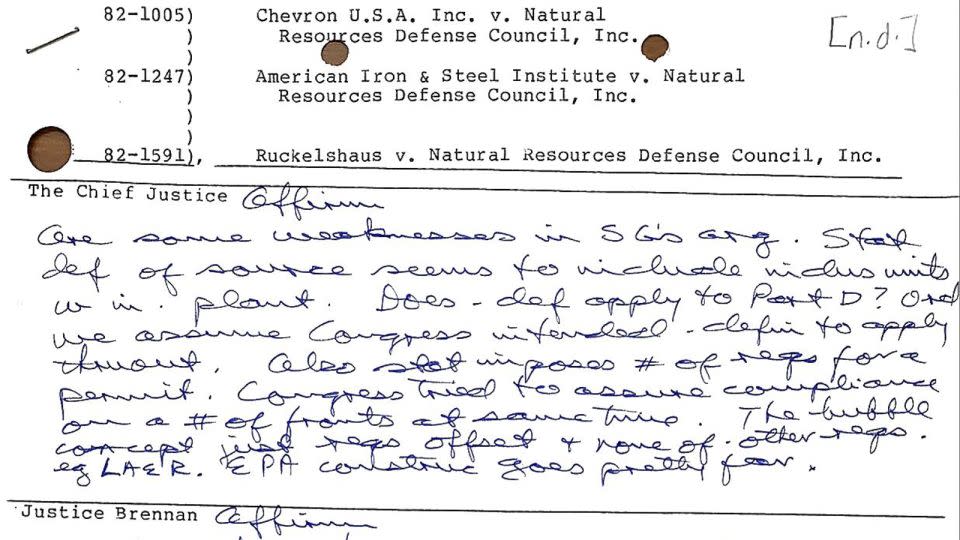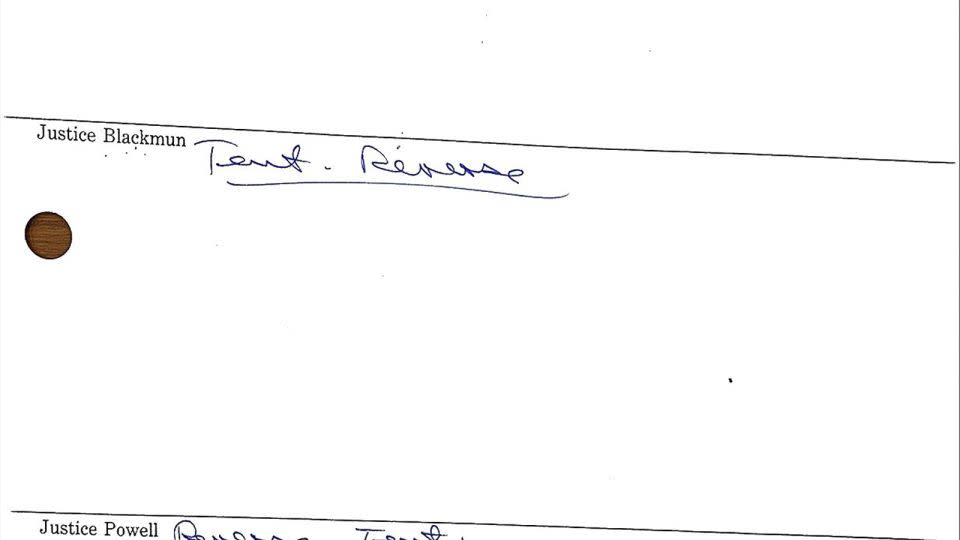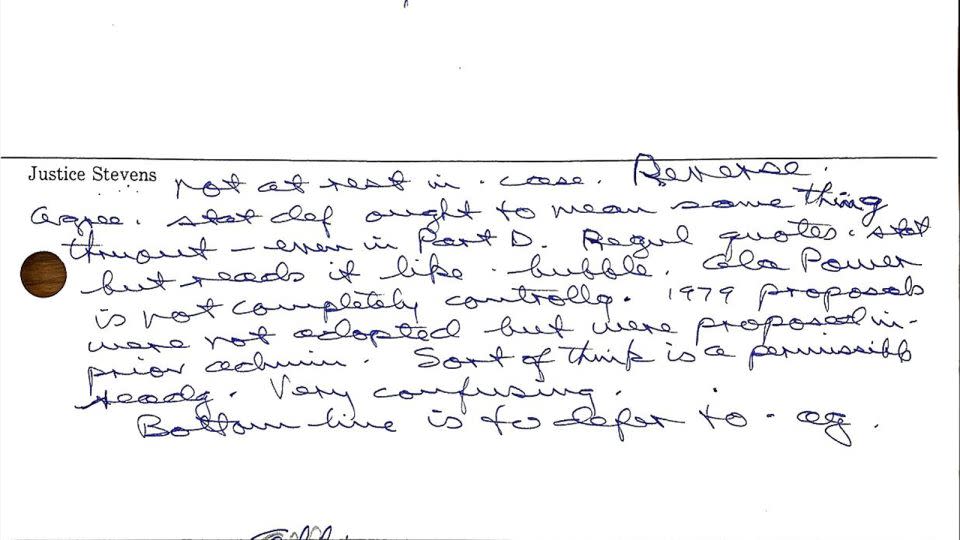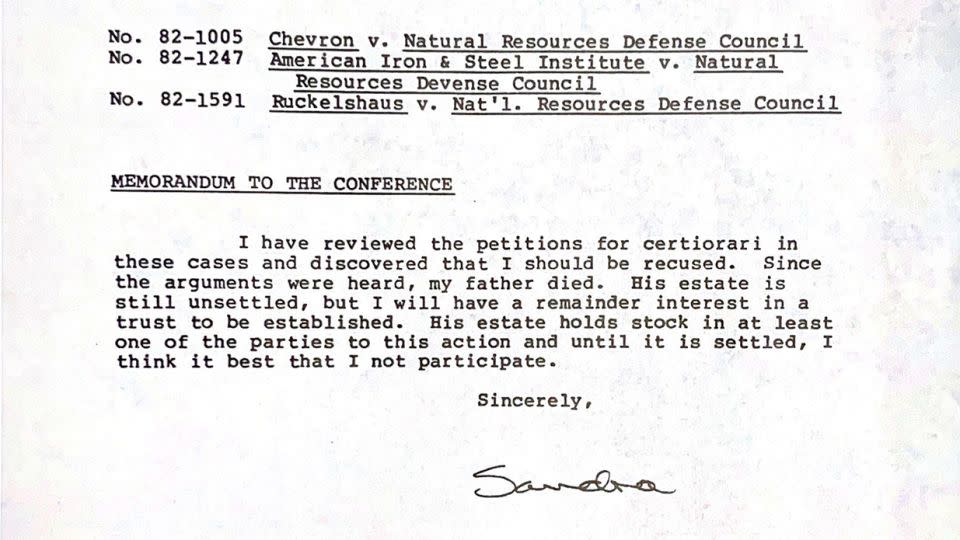What Sandra Day O’Connor’s papers reveal about a landmark Supreme Court decision – and why it could be overturned soon
- Oops!Something went wrong.Please try again later.
- Oops!Something went wrong.Please try again later.
- Oops!Something went wrong.Please try again later.
- Oops!Something went wrong.Please try again later.
- Oops!Something went wrong.Please try again later.
The newly opened papers of the late Justice Sandra Day O’Connor reveal the internal deliberations of a groundbreaking Supreme Court case that gave US regulators significant latitude to protect the environment and public health – and show how the ruling almost never happened.
The 40-year-old milestone, Chevron USA v. Natural Resources Defense Council, has become a target of the current Supreme Court and appears likely to be rolled back in a pair of pending cases this term.
“Chevron deference,” as it is commonly called, generally requires judges to accept federal agencies’ interpretations of open-ended or vaguely worded statutes regarding their mandates. Conservative critics, including Justice Neil Gorsuch, believe it has led to excessive regulation of American business by executive branch agencies. Defenders of regulatory power, including the court’s three liberals, counter that agencies – with their focused expertise – are needed to safeguard public health and welfare.
More broadly, O’Connor’s contemporaneous notes now open at the Library of Congress offer a view into how nine justices communicate in private, revealing personal predilections and some exasperation as they negotiate against looming deadlines.
In the Chevron case, testing the protections of the Clean Air Act, the papers reveal an overall tentativeness among justices as they struggled with statutory intricacies and worked toward compromise while teetering on the loss of a quorum (only six of the nine justices were on the final tally).
Yet Chevron v. NRDC became a seminal opinion, cited in lower court opinions and law review articles more than just about any other case.
O’Connor’s archive reveals its tenuous beginnings.
“It shows the case came very, very close to not being heard by the court at all,” said Columbia University professor Thomas Merrill, an administrative law expert who has written extensively about the influence of the Chevron decision. “That compounds the ‘accidental landmark’ aspect of the case. It almost didn’t exist.”


Merrill has used that phrase as he’s referred to the little notice Chevron received when it was decided and how its importance grew over the years. The principle of agency deference was fortified by subsequent decisions at the DC Circuit US Court of Appeals, which specializes in regulatory disputes, and then reinforced by the high court itself.
Chevron’s impact on the so-called administrative state has particularly spurred critics. During January oral arguments in the pair of cases that could lead to reversal of Chevron this year, justices on the right-wing majority criticized the deference to agencies.
Gorsuch said the principle favors government over businesses as well as individuals challenging government policy. He referred to “the immigrant, the veteran seeking his benefits, the Social Security Disability applicant, who have no power to influence agencies” and contended in such instances, “Chevron is exploited against the individual and in favor of the government.”
Justice Ketanji Brown Jackson, however, focused on the tension between judges and agencies to interpret statutory meaning, suggesting that the judiciary should not be in the position of effectively writing federal regulations.
“I see Chevron as doing the very important work of helping courts stay away from policymaking,” the liberal justice said. “I’m worried about the courts becoming uber-legislators.”
That sentiment echoed a concern of the late Justice John Paul Stevens, who wrote the Chevron opinion. “Judges are not experts in the field,” Stevens wrote in the 1984 case, adding, “The responsibilities for assessing the wisdom of such policy choices and resolving the struggle between competing views of the public interest are not judicial ones: Our Constitution vests such responsibilities in the political branches.”
The core Chevron principle now hanging in the balance holds that judges should defer to the agency’s construction of the statute if it is “reasonable,” and even if it differs from how judges might interpret the vague wording.
A case few wanted
The Chevron dispute began when the Reagan administration retrenched on standards for air quality and loosened state permitting requirements for new and expanded factories and power plants.
The legal question for the Supreme Court in 1984 was whether the permit process for a new “stationary source” – the phrase used in the amended Clean Air Act – required a plant-wide assessment or allowed each new pollution-emitting device to be treated separately. The Environmental Protection Agency, then run by Anne Gorsuch (the justice’s mother), said states were allowed to define “source” as meaning the entire plant, so any increase in pollution from one part of a plant, or device, could be offset by a decrease elsewhere in the plant.
After the Natural Resources Defense Council and other environmental groups sued, the DC Circuit US Court of Appeals agreed with environmentalists that the regulation conflicted with the statute and set it aside.
When the justices first looked at the Chevron appeal in spring 1983, they hesitated to get involved, according to the O’Connor papers, which enhance prior accounts in the papers of late justices. It took a while to muster the requisite four votes to even hear the case, and the number of justices who would be part of the ultimate resolution – a bare six justices – was in flux from the start.
Justice Lewis Powell thought his interest in one electric power company might require him to recuse himself. But after troubleshooting the matter, Powell found no reason to sit the case out, and on May 17, 1983, he sent a note to the clerk of the court, with copies to then-Chief Justice Warren Burger and O’Connor saying he’d be in.
Powell’s own archive at Washington and Lee University holds a note he wrote memorializing his recusal consideration: “As these cases involve an environmental law issue of some importance, and the parties probably number well into the hundreds, I have been concerned about a possible need to disqualify … I find that we already have carefully checked out this litigation, and I do not have to disqualify.”
Once Powell decided he could participate, however, he separately noted in his Chevron file that he was inclined to reject the industries’ appeal. Most of his colleagues were also ready to reject it.
According to O’Connor’s note from the first vote in the justices’ private conference in mid-May, only Justices Byron White and William Rehnquist wanted to grant the case. O’Connor offered a “join 3,” meaning she would provide the requisite fourth vote if three others wanted to hear the case. But there was no third vote at that point.
Powell asked that they all wait at least another week so he could continue mulling the dispute, and when the nine again voted at the end of the month, he was ready to provide a third vote. So, with O’Connor’s “join three” the case was accepted.
On the day of oral arguments, February 29, 1984, two justices happened to be out ill (Rehnquist and Thurgood Marshall). They both declined to participate in further deliberations on the case.
Writing the opinion
A decision in any case begins with a private vote in a justices-only session held in a small room off the chambers of the chief justice. Then the drafting begins, as an individual justice is designated to author the opinion for the court, fielding requested changes from colleagues and working to ensure that a majority holds.
The conversation typically plays out by memos circulated among the nine but sometimes a justice writing the main opinion makes a more personal appeal with a phone call or visit to another justice’s chambers.
In the justices-only conference after the Chevron oral arguments, the vote among the seven participating justices was a close 4-3. O’Connor recorded most of the justices as being tentative or “very shaky.”
She also appeared mildly irritated with Rehnquist’s withdrawal. He had been one of the bare-minimum votes to grant the case. O’Connor wrote on her tally sheet next to Rehnquist’s name: “out of case tho was one of 4 to grant!”

Differences over how to resolve the case did not fall along ideological lines, a contrast to the current polarization. Burger, a conservative, and Justice William Brennan, a liberal, were among the initial three dissenters, along with O’Connor, who disapproved of the EPA’s interpretation of the Clean Air Act.
Burger believed, according to O’Connor’s notes, that EPA had exceeded its authority in its new interpretation of anti-pollution coverage. “EPA construc goes pretty far,” she wrote as she captured his sentiment, short-handing the word “construction.”
Brennan, meanwhile, was irritated by the inconsistencies in statutory interpretation from the Jimmy Carter administration to Ronald Reagan administrations.
“EPA has changed directions, so not entitled to deference,” he said in the private session, according to O’Connor’s record. Her notes also suggest he wanted the court to tell EPA to pick a direction and be consistent.
The four justices who wanted to reverse the DC Circuit were White, Powell, Stevens and Harry Blackmun.
White, as the most senior justice of the four, asked Stevens to write the court’s opinion. Burger asked Brennan to write for the three dissenters.
The correspondence reveals Brennan’s reluctance to pen the dissenting opinion – and the overall lukewarm views of that side of the case.
“Dear Chief,” Brennan wrote Burger, with a copy to O’Connor, “I am willing to take on the dissent in this case but, particularly because we were all somewhat tentative in our votes at Conference, I hold out some hope that John will write an opinion for the court that will bring us together. I am presently in the process of drafting a letter to him on the matter. I would prefer, therefore, to take the assignment on a tentative basis and await John’s response before going forward with a dissent.”
Stevens’ files, opened last year at the Library of Congress, show that he resisted Brennan’s effort to bring more scrutiny to the EPA’s interpretation. In response to a March 6 letter from Brennan, Stevens said he had yet to draft the opinion but that he had tentatively concluded the statutory definition was sufficiently flexible to allow the EPA to take the plant-wide approach.
A few weeks later, Stevens warned Brennan that he was sure where he was headed and said it was likely Brennan would have to write a dissent.
“At long last I have found the time to get back into these cases and to begin work on a draft opinion,” Stevens wrote on May 23. “Since you wrote to me on March 6, in the hope that you might be able to escape the chore of writing a dissenting opinion if I could see my way clear to accepting your approach to the case, I thought I should let you know that I am now quite firmly persuaded that the Government is correct in arguing that the EPA’s interpretation of the term ‘source’ is permissible.”
“… In all events, I thought I should let you know that you probably will have to be writing a dissent in this fascinating case unless what I put on paper is more persuasive than my threat to make you undergo the punishment of the hurdle.”
Justices White, Blackmun and Powell remained with Stevens in the majority.
Brennan eventually had a change of heart. He asked for a relatively modest addition to Stevens’ opinion then signed on to his full reasoning and bottom-line favoring the EPA. (Stevens, writing in a 2019 memoir published shortly before his death, attributed Brennan’s switch to a personal visit Stevens made to Brennan’s chambers.)
That shift, which Brennan revealed in a note to O’Connor and all other colleagues on June 14, left O’Connor and Burger as the only dissenters in the Chevron case.
A surprise recusal
That very same day, June 14, O’Connor revealed a potential conflict of interest.
The justices decide on their own whether to recuse themselves from a case. Some recusal choices have become controversial, such as Justice Antonin Scalia’s 2004 decision to sit on a case involving then-Vice President Dick Cheney after going duck hunting with him.
A continuing point of controversy is Justice Clarence Thomas’ participation in cases related to Donald Trump’s refusal to accept the 2020 presidential election results and his supporters’ January 6, 2021, attack on the US Capitol. Thomas’ wife, Virginia, an ardent backer of the false narrative that Trump won the 2020 election, attended his rally on January 6 but did not march to the Capitol with other protesters.

Back in 1984, O’Connor’s recusal reasoning was kept private, although at the end of the decision it noted that she, Marshall and Rehnquist took no part in the decision. According to her June 14 once-confidential note to colleagues, she appears to have erred on the cautious side.
“I have reviewed the petitions for certiorari in these cases and discovered that I should be recused. Since the arguments were heard, my father died,” she wrote of her father, Harry Day, who ran the family’s Lazy B ranch in Arizona.
“His estate is still unsettled, but I will have a remainder interest in a trust to be established. His estate holds stock in at least one of the parties to this action and until it is settled, I think it best that I not participate,” she added.
That would have left Burger to dissent alone. But on June 18 he wrote a note to Stevens, with copies to the group.
“Dear John,” the chief wrote, “With others, I am now persuaded you have the correct answer to this case.”
The final June 25 decision was decided by a bare six-justice quorum. And unanimously.
For more CNN news and newsletters create an account at CNN.com

